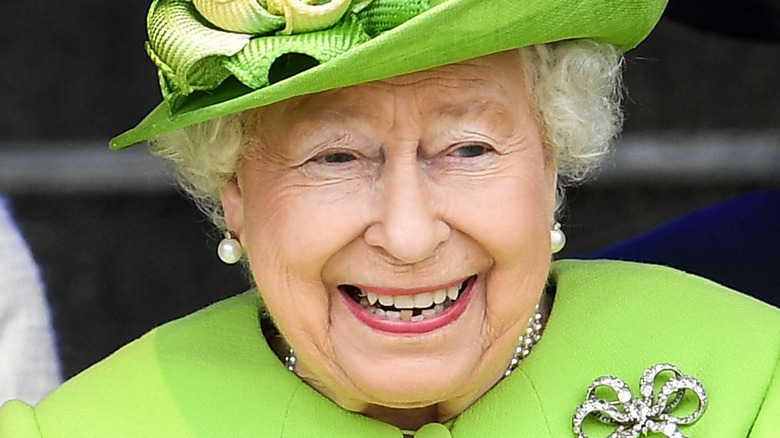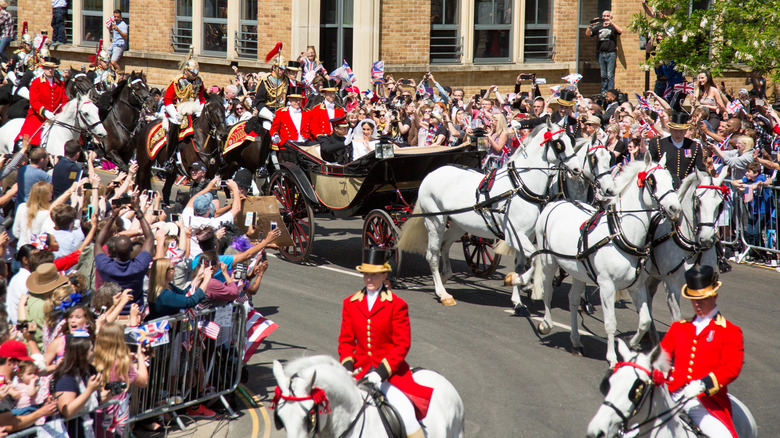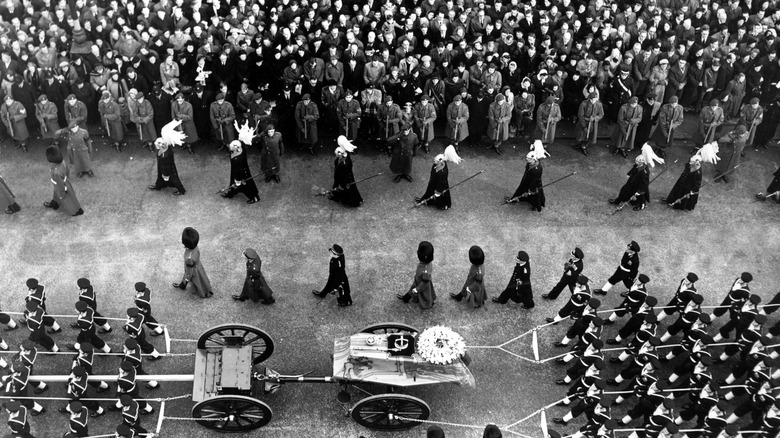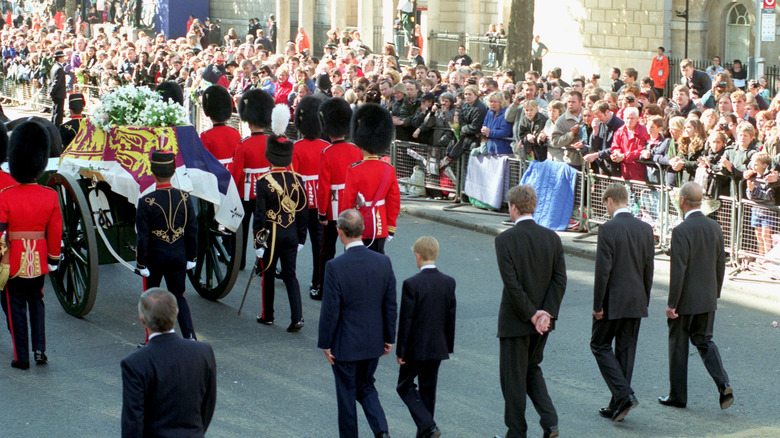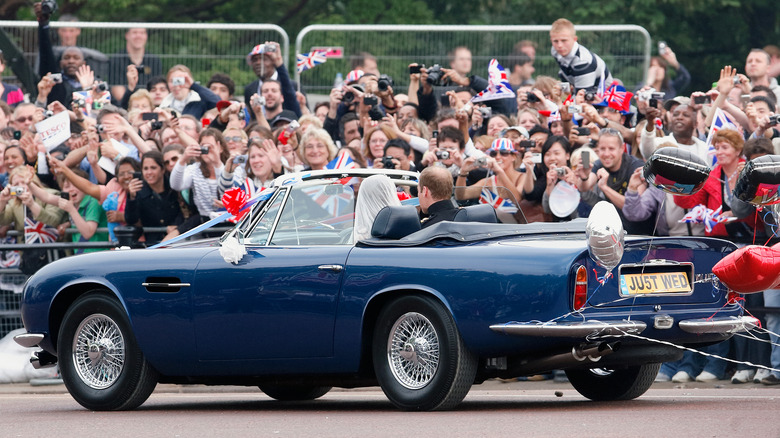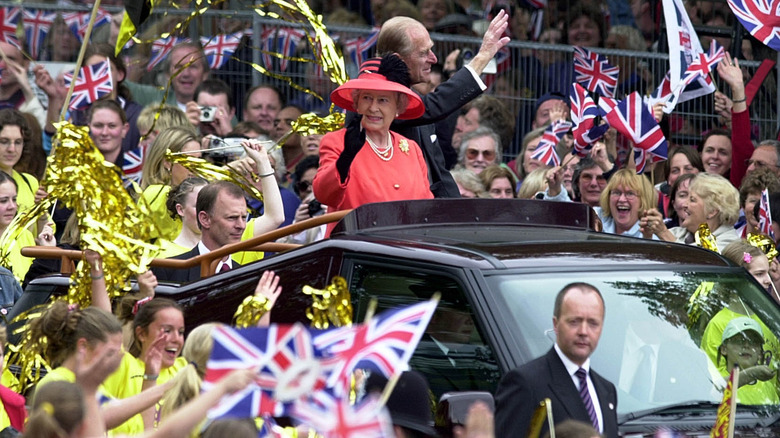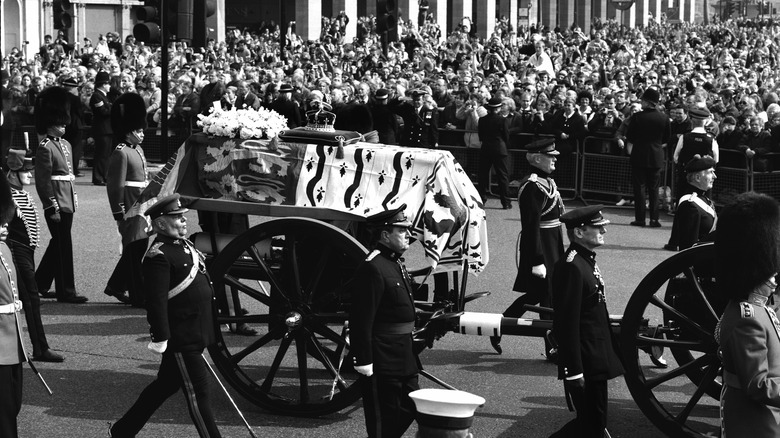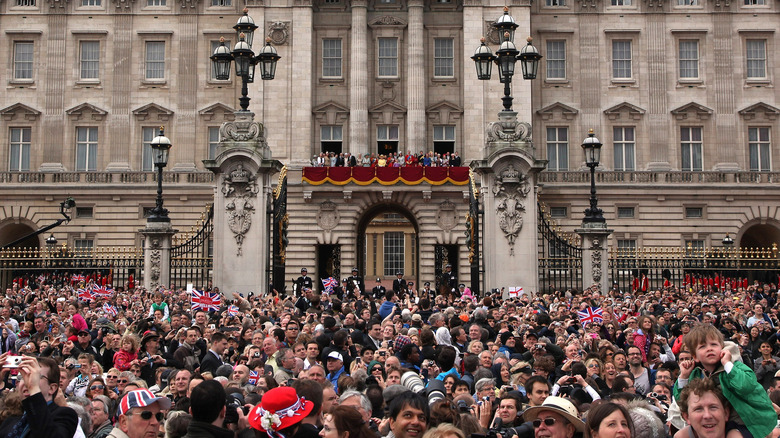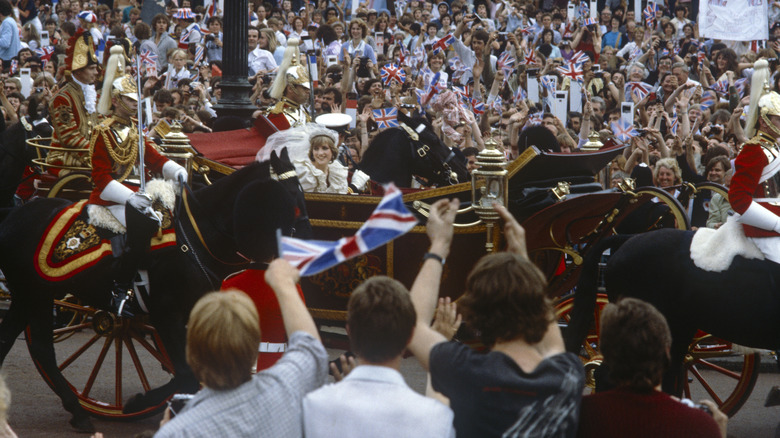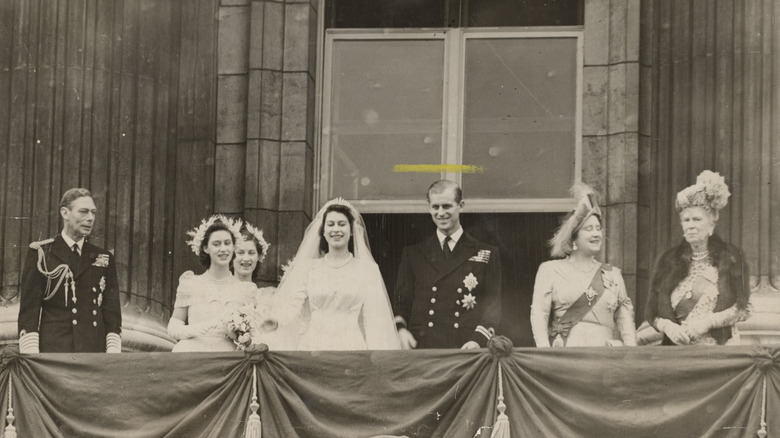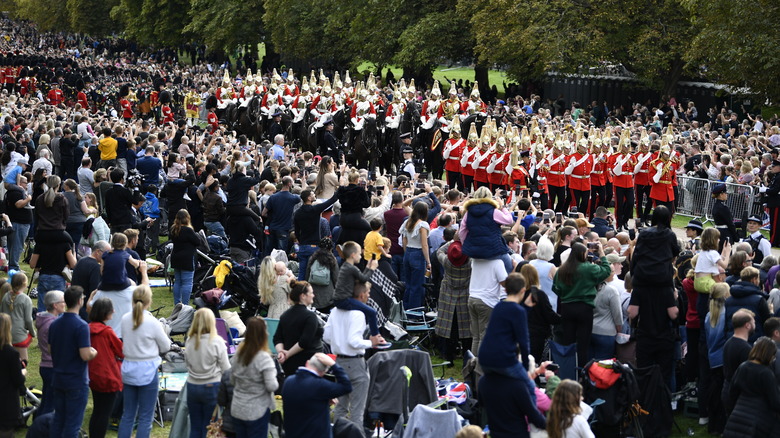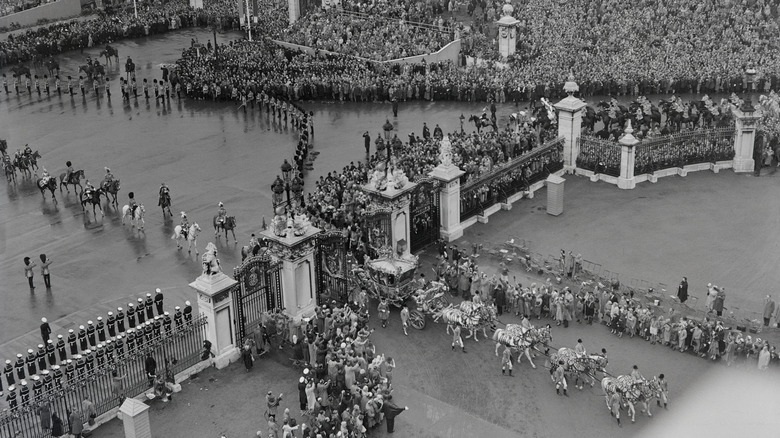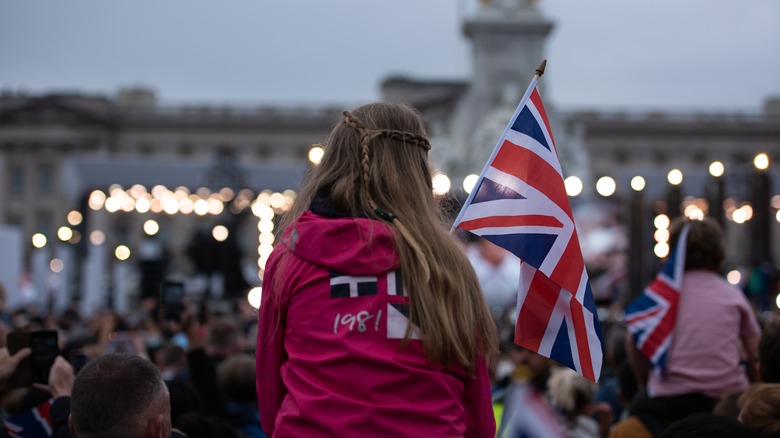The Largest Crowds Ever Recorded That Gathered For Royal Events
The second Elizabethan era ended in 2022, finishing with a major royal event that drew eyes from over the kingdom and from across the world. Queen Elizabeth II was the first British monarch to have her funeral televised (per New York Times), and it drew 26 million eyes in the U.K. alone, according to CNN. The ceremony itself was a who's who of foreign dignitaries and important people: all of the United Kingdom's former Prime Ministers, including Liz Truss herself, monarchs and royal members of other nations, U.S. President Joe Biden, and other political leaders from various countries, according to BBC News. But there were countries left off the guest list if they didn't have full diplomatic relations with the U.K., namely Russia's president Vladimir Putin.
News of Queen Elizabeth's death, along with preparations for her funeral, and the procession itself that occurred on Monday, September 19, 2022, dominated the airwaves and the papers for nearly two weeks. But this wasn't the first time that a royal event in that family captivated Great Britain or even the whole world. Read on for the largest recorded crowds gathered for British royal events.
Harry and Meghan's wedding: 100,000 people
Prince Harry and Meghan Markle got a taste of royal wedding mania in 2018 when 100,000 well-wishers lined the streets to Windsor Castle, reports the Washington Post. There was a lot to watch for since there were a lot of firsts in their ceremony. The first Black bishop to lead the Episcopal Church, The Most Reverend Michael Curry, was on hand to deliver the sermon. There were other historical moments meant to honor Meghan's biracial heritage: Karen Gibson and The Kingdom Choir performed Ben E. King's "Stand By Me," and prodigy cellist Sheku Kanneh-Mason was on hand to play, reports BBC News.
Other firsts: Prince Harry chose to wear a wedding ring, which royal grooms traditionally do not. And perhaps most notably: the Church of England approved the marriage between a royal and a previously divorced woman, a first in royal history, explains the Washington Post.
The wedding was followed by a reception at Windsor and then a black-tie dinner at the Frogmore House nearby, per BBC News. The changes in tradition continued as Meghan opted to give a speech at the reception.
King George VI's funeral: 300,000 people
George VI's service to the United Kingdom was the stuff of legend and the focus of an Oscar Award-winning film, "The King's Speech," per IMDb. His older brother was destined to be king, and George — then known as Prince Albert — expected to only live quietly as a secondary royal, per Westminster Abbey's website. But Edward VIII abdicated the throne, leaving George to take up the reins and lead England into World War II, according to Britannica. Britons were inspired by his efforts to overcome his stammer and give a speech over radio in 1939.
As it happened, his daughter Princess Elizabeth was overseas when her father died, People reports. She was in Kenya when she heard the tragic news — along with the news of her automatic ascent to the throne as Queen Elizabeth II.
An estimated 300,000 mourners paid their respects at King George VI's lying-in-state (notes Westminster Abbey), and it's not hard to see why. King George's funeral took place at St. George's Chapel at Windsor Castle, while a commemoration service occurred at Westminster Abbey.
Princess Diana's funeral: 1 million people
In 1997, Diana, Princess of Wales, died in a tragic car crash, shocking the world, according to History. The public demanded that Diana be given the royal funeral treatment, including lying-in-state, CNN reports. The queen, and the royal family as a whole, caught flack for perceived callousness since they initially only released one statement on her death. Queen Elizabeth II later gave a speech on television in Diana's memory.
Her funeral was observed in a kind of blockbuster event that has yet to be surpassed by other royal broadcasts: 2.4 billion people tuned in to watch the TV broadcast. On the ground was something similarly remarkable; more than a million people crowded the streets to watch the funeral procession, BBC reports. Many people in the crowds were visibly distraught.
The solemn event brought about the haunting images of young princes Harry and William walking behind their mother's cortege, something that was forever seared into their memories. Harry himself regrets that he was forced to do that, according to his interview with Newsweek. During Queen Elizabeth's funeral, Prince William told others that walking behind the queen's coffin took him back to Diana's procession, which occurred when he was only 15 years old (via The Telegraph). Harry was younger at just a few days shy of his 13th birthday.
Prince William and Kate Middleton's wedding: 1 million people
Young people of a new generation who were unable to witness Prince Charles and Princess Diana's sensational wedding in the '80s were eager to catch their own version of the fairy tale royal wedding of the 21st century. Specifically, 24.5 million in the United Kingdom watched the television broadcast of Prince William and Kate Middleton tying the knot, per BBC News. The scene on the street was also impressive: 1 million people turned out to watch the wedding procession. The celebration seemed to have reached every corner of England, particularly since people had the day off from work and the wedding was observed as a bank holiday.
The couple married at Westminster Abbey, and the party continued at Buckingham Palace. It was there that they appeared on a balcony, witnessed an RAF flyover (via the royal family's official website), and shared a kiss, continuing the mistaken tradition started by William's father in his wedding to Diana, according to History.
Queen Elizabeth's Golden Jubilee: 1 million people
In 2002, Queen Elizabeth II celebrated 50 years on the throne, and as with many 50th anniversaries, the celebration was a big one. A sort of music-through-the-ages concert ensued at Buckingham Palace, exploring the evolution of music throughout her reign, as 1 million people gathered to watch this and other festivities at the palace, The Guardian reports. The event was called Party at the Palace, and a parallel concert for classical music exclusively was called Prom at the Palace, per BBC News. It featured performances by Elton John, Paul McCartney, and Aretha Franklin, along with a coordinated nationwide performance of The Beatles' "All You Need Is Love." Choirs across the country joined in, and thousands of people observed the spectacle on giant screens erected in public parks, CNN reports.
Although 50 years was something to celebrate, it was a dark year for the queen. Her sister, Princess Margaret, died at the beginning of the year, which was then followed by the death of her mother, the Queen Mother, per Newsweek. Princess Margaret requested a private funeral and broke royal protocol by having a cremation (per iNews U.K.), while the Queen Mother's state funeral saw the same-sized crowds as the Golden Jubilee (per France24), giving Queen Elizabeth quite the roller coaster year.
The Queen Mother's funeral procession: 1 million
Like Queen Elizabeth II, Queen Elizabeth, the Queen Mother, had been a constant presence for Great Britain when she died at 101 years old in 2002, per Westminster Abbey. Born in 1900, she saw two world wars, the coronation of her daughter, and the modern transformation of the royal family. So it's no surprise that she was held in high regard in England, and 1 million people lined the streets to view the funeral procession, reports France24. And 200,000 paid their final respects during her lying-in-state. Her grandsons, including Prince Charles, stood guard in the Vigil of the Princes, ITV News explains.
The Queen Mother's funeral was the last royal funeral with a lying-in-state before Queen Elizabeth II's, and there were many similarities between the both of them: mourners were able to observe their coffins at Westminster Hall before they were transferred to Westminster Abbey for the funeral, per Yahoo! News. They were then both buried alongside other members of the family at St. George's Chapel.
Queen Elizabeth's Diamond Jubilee: 1.2 million people
In 2012, Queen Elizabeth II achieved what only one English monarch before her had been able to accomplish: a diamond jubilee. The event marked 60 years on the throne, something that only Queen Victoria, Elizabeth's great-great-grandmother, was able to live to see, according to BBC News. It was no surprise then to see an impressive number of people showing up to jubilee events, along with 14.7 million watching on television, The Guardian reports. For the Thames River Pageant alone, which saw members of the royal family waving from an elaborately gilded royal barge (per CNBC News), 1.2 million people lined up in the rain.
The event came amid economic austerity in Great Britain, and town councils across England were reluctant to spend taxpayer money on celebrations, The Guardian reports. Even the cost of the river pageant was expected to come from private fundraising. Additionally, Prince Philip's growing health struggles sidelined him for the last jubilee events, per Time. The Duke of Edinburgh made his way to a hospital via ambulance only hours before the jubilee concert, and many were worried about his overall health decline. The occasion marked one of his first major absences from public services, and he would later retire in 2017, BBC reports.
Prince Charles and Diana's wedding: 600,000-2 million people
Prince Charles and Lady Diana Spencer's wedding is easily the wedding of the 20th century, and the most memorable. On July 29, 1981, 750 million people tuned in to its television broadcast, a feat yet to be eclipsed by any royal wedding since, according to BBC News. A similar spectacle occurred on the streets of London —somewhere between 600,000 (per BBC News) to 2 million people (per People) crowded the procession to catch a glimpse of the real-life fairy-tale wedding. The event took place at St. Paul's Cathedral, which Diana rode to in a horse-drawn glass carriage, dating back to 1881, from Clarence House, People reported. To complete the storybook quality of the event, her $12,000 dress had a train that was 25 feet long.
A couple of mistakes and not-so mistakes were made at the ceremony. Diana got her husband's name wrong at the altar, calling him Philip Charles Arthur George instead of Charles Philip Arthur George, and Charles forgot to kiss his bride, History explains. Diana also left out the part in her vow promising to obey her husband, but that was more deliberately done.
Alas, the only thing missing was the "happily ever after," since the two ended up divorcing 15 years later after their life together grew sour.
Queen Elizabeth II and Prince Philip's wedding: 2 million people
The wedding to rival that of Prince Charles' was that of his parents — Queen Elizabeth II and Prince Philip's 1947 wedding. Elizabeth was not yet queen, and Philip was just made The Duke of Edinburgh, as noted by the royal family's official website. The ceremony took place at Westminster Abbey, where 2,000 guests were gathered. But outside was a more remarkable crowd; an estimated 2 million people lined up in the streets for the wedding procession to and from the Abbey, the Sydney Morning Herald reports. After all, it was after World War II, and the country needed something like a wedding.
Elizabeth was walked down the aisle by her father, King George VI, along with Philip. Behind her was a 15-foot train on a dress she famously paid for with war ration coupons, per Royal U.K. The pomp and circumstance of the wedding, which included a 9-foot-tall cake, proved to be worth it: Queen Elizabeth and Prince Philip had the longest marriage in British royal history at 73 years, per People.
Queen Elizabeth II's lying-in state and funeral: 2 million people
Queen Elizabeth II's coffin had quite the journey after her death on September 8, 2022, affording Britons several opportunities to pay their final respects. After sitting for a few days at her summer home at Balmoral Castle (per the New York Times), the queen's coffin was driven to Edinburgh, where approximately 26,000 mourners lined up at St. Giles' Cathedral to pay their condolences (via CNN), along with members of the royal family, NBC News reports. Her coffin was then flown to London and then driven to Buckingham Palace, where it waited in the Bow Room (via CNN) until it was transported to Westminster Hall (per the New York Times), where members of the public could attend her lying-in-state.
From Wednesday, September 14, to the early hours of the following Monday (according to U.K. Parliament), mourners flocked to Westminster Hall to see the queen's coffin in a line that snaked for 10 miles down the River Thames, with an average wait time of more than 24 hours, BBC News reports. Officials expected the attendance to fall between 750,000 to 1 million mourners, per The Guardian. The queen's coffin was then transferred to Westminster Abbey for her state funeral, and up to 2 million people were expected to line the streets to catch that procession, along with the coffin's journey to its final resting place at Windsor Castle, the Washington Post explains.
Queen Elizabeth II's coronation: 3 million people
In 1953, Elizabeth II was crowned queen in a ceremony millions tuned into by radio and television broadcast, per BBC News. But a whopping 3 million people crowded the streets in London to watch the queen travel to and from Westminster Abbey, where the ceremony took place. She ascended the throne only 16 years after her father's own surprise coronation, and seemingly, Buckingham Palace was unprepared for the transition, People explains. King George VI's death, which occurred in his sleep (per BBC News), seemed to come out of nowhere, and so the coronation was delayed in order to prepare properly. However, it was also delayed in order to honor an appropriate mourning time for the queen's grandmother, Queen Mary, who died three months before Elizabeth was crowned, according to Mental Floss, and also to schedule the ceremony during happier, sunnier weather in June, reports BBC News.
The ceremony was unprecedented since it was the first British coronation to be broadcast on television, with an estimated 27 million people tuning in, per People. In fact, it was the first time many people had watched an event on television, according to the royal family's official website. Top it all off, there were 8,251 in attendance at Westminster Abbey, including her son Prince Charles.
Platinum Jubilee weekend: up to 17 million
Queen Elizabeth II's 2022 Platinum Jubilee was monumental for several reasons. For one, she was the only English monarch to have celebrated it, according to ABC News. The occasion marked 70 years on the throne, making her the longest-ruling monarch in British history. There were events held across the country in what had to be one of the largest national celebrations in recent history: nearly 17 million people celebrated the event across numerous single events during the jubilee weekend, The Guardian revealed. The Jubilee weekend — which fell on June 2 to June 5, 2022 (per the royal family's official website) — coincided with the Together Coalition's Thank You Day Campaign, a nationwide event organized to honor the queen's public service and encourage Britons to celebrate within their communities (via Together U.K.). Various street parties were held throughout the country, and they received the help of 3.3 million organizers.
There was a sense in the air that the jubilee would be the queen's last, as detailed by the Washington Post. At 96 years old, the queen went to fewer events than she did at her diamond jubilee, with her doctors citing issues with mobility. She ended up skipping the concert at Buckingham Palace but made up for it with a video appearance alongside Paddington Bear, per ABC News.
